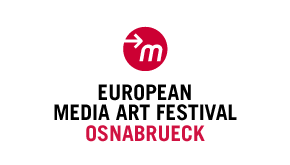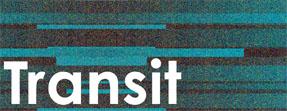
European young talents forum
1 Sep 2009 - 31 Aug 2011
In 2009, the European Media Art Festival initiated TRANSIT as a European project to promote students of Media Art. Students are to be given the opportunity to attend workshops where they can develop artistic projects to the presentation stage. They shall also be given the chance to exhibit their work at internationally renowned festivals. In cooperation with the festival Videoformes in Clermont Ferrand (F) and the artists’ centre FLACC in Genk (B), the concept of the network was born in close collaboration with Contour Mechenelen (B). Ten higher education institutions and academies from Tallinn (EST), Poznan (PL), Kiel (D), Karlsruhe (D), Enschede (NL), Ghent (B), Brussels (B), Le Fresnoy Tourcoing (F), Poitiers (F) and Clermont Ferrand (F) are also involved in the project - outstanding schools in six countries of the European Union.
Partner
European Media Art Festival
The EMAF or European Media Art Festival (Osnabrück, Germany) is one of the most influential forums for international media art. As a meeting point for artists, curators, distributors, galleries and an audience of experts, the festival has a great impact on the topics and aesthetics of media art.
Each year the festival offers its visitors a current overview of experimental films, installations, performances, digital formats and hybrid forms, with content ranging from personal and political subjects to formal experiments to provocative statements from the pulsating area of “Media Art – Society”. The festival sees itself as a place of experimentation and a laboratory where extraordinary works, experiments and ventures are created and presented.
Vidéoformes
Since 1986, Vidéoformes (Clermont-Ferrand, France) has organised an annual international video and new media art festival. This event highlights the quality of the works and artists presented in the festival through exhibitions, lectures, screenings, debates and meetings. Famous and young artists get to meet around various festival events, such as video installations, cinema and video films, performances, web art and live video and music performances (VJ and DJ sets).
Aside from the festival, Vidéoformes has been running an alternative gallery, Galerie de l’art du temps, and publishing a quarterly magazine about contemporary art and new technologies, Turbulences Vidéo, since 1993. Vidéoformes runs an Artists-in-Residency programme and is now involved in a European project funded by the European Community. Vidéoformes is also engaged in the development of Digital Video Archives, one of the most important video and electronic art collections that has been put together in over twenty years. This collection is now available in an open database to the public.
FLACC
FLACC is a workplace for visual artists and creates the conceptual, organizational and technical conditions for realizing unique artist projects. Every year, FLACC selects ten artists to set up a new project. In each annual selection, FLACC aims to strike a balance between national and international artists, between beginners and artists with experience, between autonomous art and/or research projects and artists that deal in more concrete terms with the historical, geographical or social context of the workplace.
FLACC has metal and woodworking workshops, a digital studio (film and photography), and a foundry with a furnace and kilns for ceramics, bronze and glass applications, and an extensive workspace. The staff is knowledgeable about the production possibilities of nearby workplaces and collaborates with those workplaces and with schools and companies to give the artists the best possible support and assistance. Here you can find an overview of all the facilities.
Artists
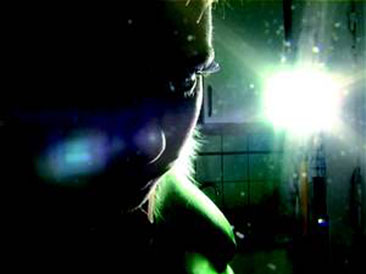
Nadine Ibo Bachmann von Werder
»move. crouch. roll.«
Kiel, Essayfilm. D 2011
A movie about me. My life, my inner life. Commented and viewed from the outside, through the eyes of others. The movie deals with memories of drug excesses, depression, breakdowns and moments of freaking out. Seemingly happy party life and nostalgic family memories are subtly unmasked and turn into horrible situations and fairy-tale fiction. The focus is on living with emotional lability (borderline personality disorder) and the traces it leaves. The interviewees tell the audience how they experienced moments and parts of my life. But the statements given by the interviewees seem questionable. Everybody has different memories and a different opinion. These differences are emphasized in the editing process of the movie. Therefore, the view from the outside world is fragmented like a kaleidoscope. The combination with the dream-like inner world images blurs the border between reality and imagination. The movie intends to show that there is more than one truth. The objectivity of film as a communication medium is questioned. Parts of real experiences turn into fictional filmscenes.
Nadine Ibo Bachmann von Werder, *1975 in Berlin, studies Time-Based Media in Kiel
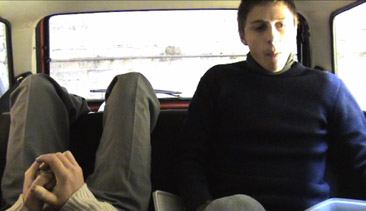
Gertjan Bisschop
»Car/Circle of fourths«
Wevelgem, Film, B 2010
Gent, Film, B 2009
Car (2010, Wevelgem) and Circle of fourths (2009, Gent) are two films, each is set in a closed, one-space environment (microcosmos). Central to both films are the possibilities presented in these two self-created systems. I want to explore the process of formation. How does one element produce the other, how can one actor produce the other?
Gertjan Bisschop, *1986 in Gent, studied Master of Fine Arts at Sint-Lukas Brussel
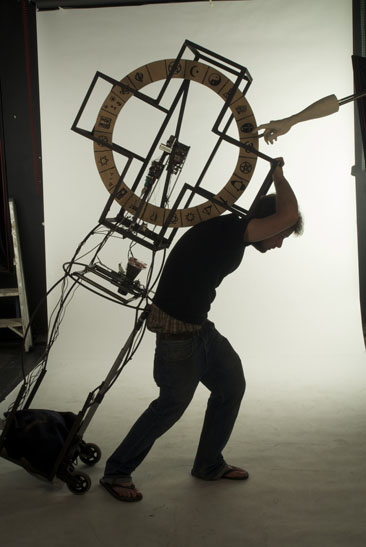
Philip Boettger
»Kreuz«
Enschede, Installation, NL 2010-2011
This work is a personal reflection on religious institutions and how you are born into them. It is running autonomous in an infinite loop. First the microcontroller generates a random GPS location, representing a new life, born somewhere. After that the wheel will spin and pick a random religious orientation. Depending on the chosen religion, a symbol will be burned onto a small piece of plastic and tossed out onto the floor. The whole procedure will repeat itself infinitely.
Philip Boettger, *1984 in Essen, studies “fine arts sculpture” at “Academie voor beeldene kunsten Enschede”, Netherlands
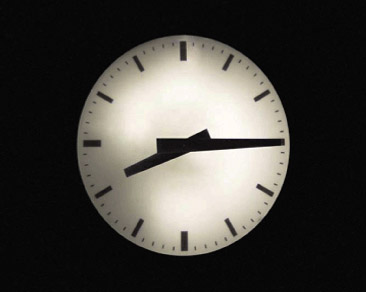
Jean Bonichon
»H-Shima«
Clermont Ferrand, Installation, F 2010
H like the Hour : a quarter past eight a.m, Enola Gay the american bomber drops his bomb.
H like H bomb : Little boy, first atomic bomb.
H like Hospital : Hospital Shima, precise impact point of the explosion.
H like Hiroshima : town which had been completly eradicated, August 6th, 1945.
Fixed needles show the terrible hour while the clock itself endlessly turns in reverse. Its perception is disturbing and fear is born from this humanistic decline. My art work turns between the absurd and declension in a serious tone. With my photographs, videos and my narration I develop and explore a daily mythology of whom even I sometimes become the object.
Jean Bonichon, study of DNSEP (French Master of Art) at Clermont-Ferrand Art School (ESACM) in 2010
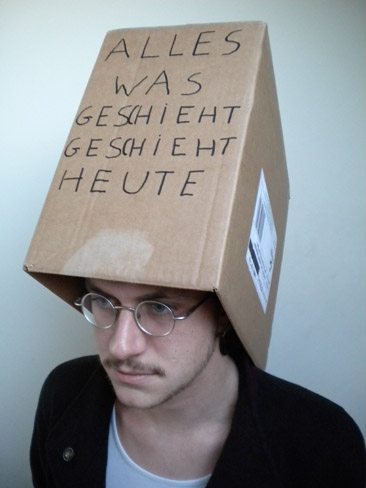
Nick Defour
»ALLES WAS GESCHIET GESCHIET HEUTE«
Brüssel, Performance, B 2011
The performance consist of the following elements: A poster (60x80, same as the image for the catalogue), a clock (whitout the arms but it is still ticking) and a cardboardbox. The poster and the clock are attached to the wall at eyelevel. In front of it I will put the cardboardbox (I will remove it from my head) and step on it. (Than it crushes) And I will say aloud with changing volume and rythm “ALLES WAS GESCHIET GESCHIET HEUTE”. After the performance the clock, poster and cardboardbox stay as an installation.
Nick Defour, *1988 in Halle, Belgium, finished his MA degree in Fine Arts at Sint-Lukas Brussel University in 2010.
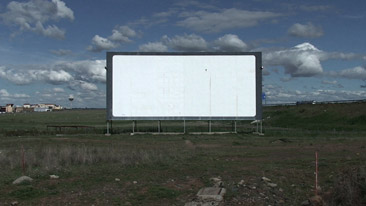
Justine Emard
»Blank Screens«
Clermont Ferrand, Installation, F 2010
The multi channel installation « Blank Screens » results of a research about landscape and moving images. It shows different places where images are directly involved in the landscape through a screen, mostly drive-in theaters, abandoned or opened. The serie is a witness of the position and the projection of images in a context, a setting, a landscape, a particular place and the power it exercises over the place (traffic, maintenance or abandonment of the place, advertising or media ...).These short videos have been shot in different countries with the ideas of transit, roaming and wandering. Images in these videos seem to be absent through blank or suggested screens…
Justine Emard, *1987 in Beaumont, studied art at Ecole Supérieure d'Art de Clermont Métropole and the School of Art of Oklahoma University.
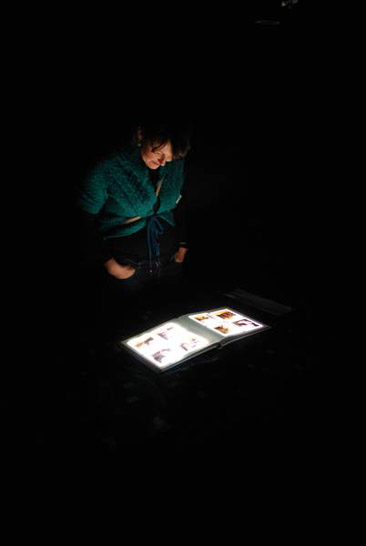
Philipp Engelhardt
»Hildapromenade«
Karlsruhe, Interactive Installation, D 2010
At Hildapromenade 4 in Karlsruhe I found an old blue photo album in the bulky refuse. I started skipping through it and it sparked an interest. In the album were no references regarding time, names or text elements. But the photos which were quite uncharitably glued into the album were somehow telling a story. The story was nothing fancy, it seemed to be about a middle-class woman in the 1960’s who was celebrating her retirement at the office she was working for.
The book, which I believe was a present of her colleagues, was half filled with photos of her retirement party. Afterwards she or her husband completed the rest of the album with their private photos. It is a mixture of some older black and white and some newer photos showing their so called evening of life. In a curious way it made the memories to my grandparents, who died when I was a kid, somehow exchangeable. The real and the fictitious ideas were almost equal. In my imagination I saw the woman, sitting in front of here desk slightly moving around, posing, smiling into the camera and talking to the photographer.
I wanted to revitalize the photos and rebuild the memories in a way of moving pictures. To illustrate this I used a 3D application to reconstruct the woman in 3D space. For me it was not the most important point to perfectly rebuild the character in 3D or make the movements 100 percent anatomically correct, the reconstruction was more like a fragmental memory.
I found a double page in the book which is telling a consistent story.
It shows eight middle format 6x6 photos, which were shoot in the garden around the house.
I started to arrange the photos in a chronological way to make sure the animated woman can move logically connected from one photo to the other. The order I chose is a self-contained loop in which the woman is walking through every photo at least once. In each specific photo the 3D animated woman is adopting the pose of the woman on the original photo for a few seconds before moving to the next scene. However for the video I only used the background and removed the woman out of the scenery. In this way I created an empty stage for the animated 3D model. In the end the video is projected over the original photos.
Philipp Engelhardt, *1978, studies at Staatliche Hochschule fur Gestaltung Karlsruhe, Germany
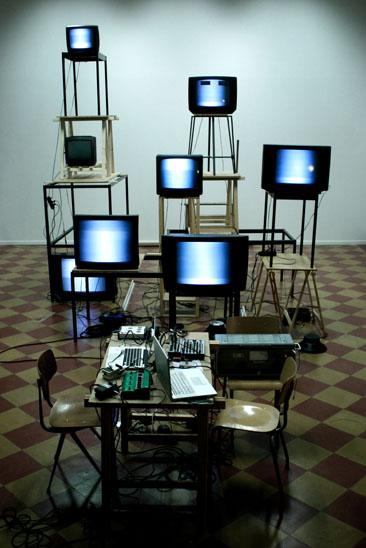
Valentijn Goethals
»PIECES OF QUIET«
Gent, Installation and Performance, B 2011
PIECES OF QUIET creates a closed circuit between image, sound, installation and performer, using reassembled televisions and electronic devices. In this search for interaction, a rare and sincere direct situation is created in which every part is tightly connected, resulting in a sensation of maximal intensity in the audience's eyes. When sound is directly translated to image, without a precomposed digital prefix, an intuitive desire for interaction between the image and the sound is born in the mind of the performer. The fixed circuit imposes specific compository limitations on the performer, the image hence becomes instrument, producer and composer. The performer becomes both master and slave to the image that is produced.
The visual sensations that are produced by the installation are simple and fundamental. Extremely abstract visualizations present themselves as a direct and analog manifestation of sound. Mere fluctuations of shadows and light create an experience that is both unoriented and meditative.
Different frequences and amplitudes—including barely perceptable sounds—produce a series of pulsating horizontal lines on the telivision screens, whose breadth varies according to the changes in frequency. By transmitting the audio directly into the television, Pieces Of Quiet has no need for new software to visualize sound. To the contrary, they step into the potential that is imbedded in the bad connections between existing media.
Valentijn Goethals, *1987 in Torhout, studied graphic design at Sint-Lucas visual arts Ghent in 2009, now studying experimental arts.
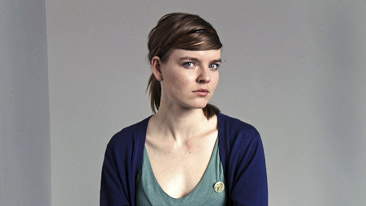
Felix Grünschloss
»Selfportraits«
Karlsruhe, Installation, D 2011
A person is sitting in front of a semi-transparent/one-way mirror. He or she is looking themself in the eye, thus watching themself watching themself. Given that the person is aware of the fact that behind the mirror, the camera/the recipient is looking him or her in the eye, he or she cannot help but stage themself in some way or another. The session/selfportrait lasts a full hour. Anything is permitted (talking, making faces, etc.) as long as the one and only rule „remain seated and watch yourself“ is followed.
Felix Grünschloss, *1977 in Stuttgart, has studied Media Art at HFG/ZKM Karlsruhe
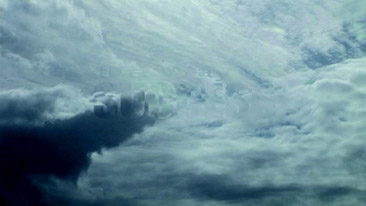
Michael Gülzow
»The Way to Success«
Kiel, Video, D 2011
On a superficial level The Way to Success is supposed to be seen as a motivational film promising success in life and business. On a deeper level it questions the striving for power, beauty and success in today’s society and puts the viewer to the test on how much he accepts to be true. The film is put into scene in the style of a documentary fiction film. Acted scenes are sequenced by informational 3D graphics and voiced over by a narrator.
Michael Gülzow, *1982 in Kiel, studies at Muthesius Kunsthochschule Kiel since 2004

Semra Henin & Jill Teichgraeber
»Moncley«
Kiel, Video Installation, D 2010
The new project of the artist duo TEICHGRÄBER_HENIN wants to continue their sequel of the neverending dream. This project is using the cultural location of CHATEAU DE MONCLEY (France). It is not used as a static place but as a source of history, cultural heritage, contemporary witness and as playing court. Moncley functions as a playground and a labyrinth, in which the experiment takes place. The young woman starts to communicate with another person who seems to be herself. The multiple film location is the engine of their present project, the artist duo is looking for the secrets and there are more to come. The mighty monument offers hiding places, prisons, protection, hallucinations, mazelike, historical atmosphere, music, sky, mirrows, darkness, a lot of dust, strange eyes, cold stones, spiderwebs and dead butterflies, carpets of dry flies, transparent material, paintings, fountain, fir tree and flowing blue.
Semra Henin & Jill Teichgraeber, both *1982, study at Muthesius Kunsthochschule Kiel, Germany
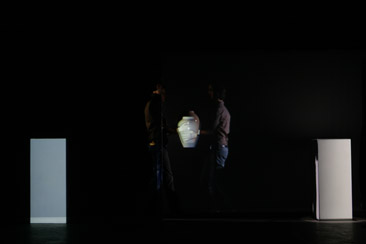
Kilian Kretschmer
»Save«
Karlsruhe, Videoperfomance, D 2010
In my video performance SAVE, I confront media-based forms of representation with reality. The central element of this performance is a VASE, whose anagram results in the titel. The simple plot is the save transport of this vase from pedestal to another. The stage consistsof two screens arranged in an offset pattern. I re-enact a film which is projected on the left screen in the front and is synchonously mirrored to the right screen in the back. When I disappear behind the left screen, I simultaneously appear on the right one as a live-projection. Thus a complex and confusing network of different layers of time and space unfolds. While collapsing, the fragments become an ensemble.
Kilian Kretschmer, *1983, studies Media Art at Karlsruhe University of Arts and Design

Ju Hyoung Lee
»We’ve never seen a night which has finished by reaching a day«
Poitiers, Video Installation, F 2010
Mrs. KIM Hwa Seon was born in Pyong-Yang in 1926. She was fifteen years old when she was kidnapped by Japanese soldiers. At military bases located in Singapore and in China, she was forced to serve Japaneses soldiers as a sex slave. This film is composed of a dialogue between her and I, and a litterary monologue about a prostitute during the Algerian war. It shows the suffering and the emotion of a women who has been excluded from our collective memory.
Ju Hyoung Lee, studies at the European School of Visual Arts Poitiers, France

Katarzyna Pacura
»Mother’s Cell«
Poznan, Video Installation, PL 2010
Katarzyna Pacura, *1986, studies at the University of Arts Poznan, Poland
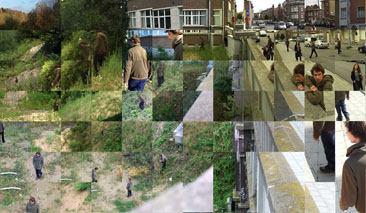
Stefan Piat
»The bridge«
Gent, Photography, B 2010
Build with photographs taken from various viewpoints, The Bridge shows us a place where a person walk through. By representing simultaneously differents events, this work deals with the introduction of the time into the construction of a photography.
Stefan Piat, *1979, studies at the St Lukas Hogeschool Gent, Belgium

Felix Porato
»At 250 miles per hour«
Poitiers, Video Installation, F 2010
Rick, Sylvia and Tim, three middle-aged persons, wanting to get away from boredom, decide to pursue the crazy dream: to go and bomb a boom in the west side of the United States. During their journey from East to West, they will realise that it is impossible to return to the life they had before, and to get back to society.
Inspired by Jim Harrison’s “A good day to die“.
Felix Porato, studies at the European School of Visual Arts in Poitiers, France
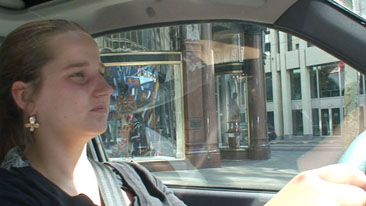
Ilse Proost
»Voyage A Belgique«
Gent, Video Installation, B 2010
For the video - Voyage ‘A’ Belgique – Ilse Proost drove 18 hours and 37 minutes through her homeland. A GPS accompanies her to all cities in Belgium that start with the letter A. The combination of a self-portrait and the passing scenery, combined with the voice of the GPS provides a complex and intriguing atmosphere
Ilse Proost, studies at the St Lukas Hogeschool Gent, Belgium
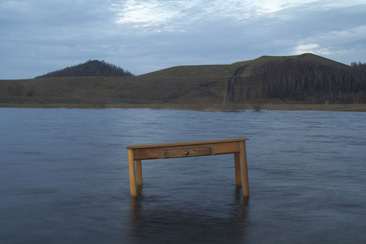
Enrique Ramirez
»TAFEL«
Tourcoing, Le Fresnoy, Installation, F 2011
TAFEL is a project that takes a journey and an imaginary conversation between the two main Belgian cultures: Walloon and Flemish. While listening to interviews with Belgian politicians, the audience sees two tables floating in a lake. Two tables like the two divided cultures, different social policies that are often incomprehensible. TAFEL is an excuse to take up these questions and to reflect on some invisible differences and separations. TAFEL takes us back to two places and exemplifies a forced union of elements that are physically alike but culturally distinct. It shows the differences and similarities between two worlds, two languages; a place that bears a single name, but is divided by invisible walls. A place that is based on the same foundation but at the same time separated by a fissure.
Enrique Ramirez. * 1979 in Santiago Chile, 1999-2002 BA in Film Studies - Instituto de artes y comunicación ARCOS, Chile. 2007-2009 master en studio national of contemporary arts, Le Fresnoy, France
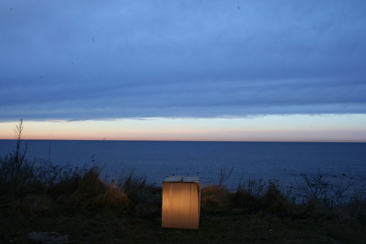
August Sai
»Map is not the territory«
Tallinn, Video Installation, EST 2010
The most durable myth is the one claiming that people are a part of nature, that people are something else outside themselves. What is the force that has kept people‘s thoughts within these coordinates?
The image people have of themselves - can it be destroyed, torn up by the person themselves? Is it possible to dissolve oneself within oneself so that you cannot even recognise yourself anymore, and then to construct, to program a new “I“; to distance oneself from one‘s own vision and manipulate the constructions inside oneself, in connection with one‘s own subject with no possibility of controlling the substance that makes up the nature of a person‘s “I“, the well-established patterns that are impossible to break or to tear up, at the same time being the object that is being broken (substance) as well as the one that breaks it, the intruder. There is no reality outside the viewer. Reality only exists in our own heads, minds, consciences. It is possible to experience reality through the illusory.
August Sai, *1983, studies at the University of Fine Arts Tallinn, Estonia
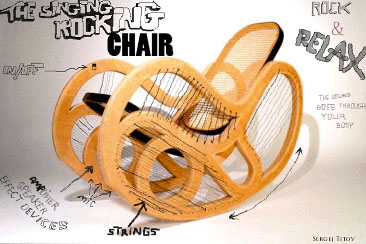
Sergej Titov
»The Singing Rocking Chair«
Enschede, Interacitive Installation, NL 2010
My singing-rocking-chair project has been in the development for some months now. The idea was to build a rocking-harp-chair. This idea is inspired by therapeutic musical instruments. In music-therapy the whole body is connected to the instrument. The oscillation of the strings goes through your body. This has a pleasant and curative effect.In my installation people can sit, swing and rock. You can sit, relax and pull the iron strings on the side of the chair. A microphone under the chair catches the oscillation. The oscillation goes through effect-devices, through the amplifier, to the speaker and finally through your body. Sensors perceive the movements of the swinging chair and change the sound during the swing. My motivation is, to see how people react to the installation and its effects.
Sergej Titov, studies at AKI Artez Academy for Fine Art and Design (Enschede, Netherlands)
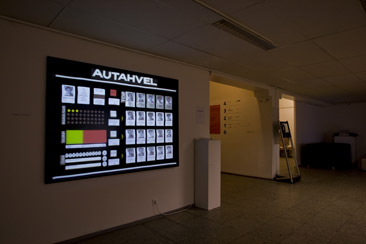
Timo Toots
»Hall Of Fame«
Tallinn, Interactive Installation, EST 2009-2011<7b>
“Hall of Fame” is an installation that calculates the artistic potential of the visitor. It uses travel documents to identify persons. Visitor’s ID-card or ePassport are scanned and processed. The results of the calculations are displayed as graphs on the board. The top of best artists is shown as a grid of portraits and names. The algorithm for the artistic potential is following:
ARTIST = LUCK + FAME + DEATH
LUCK is calculated from data the visitor has no disposal of.
FAME is calculated from Google hits.
DEATH is calculated from the person’s average life expectancy.
A dead artist is the best artist.
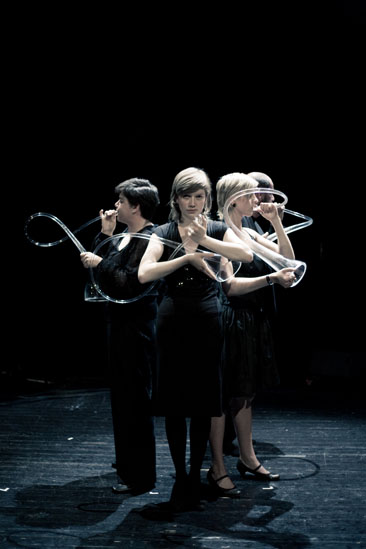
Charlotte Van Wouwe
»Soplarte«
Gent, Performance, B 2008
Soplarte was founded in Autumn of 2008, out of Charlotte Van Wouwe’s urge to unite sound and image. This resulted in the first glass-blown wind instruments. Experienced musicians were asked to join the search fpr different the possibilities of these instruments. A few months later, the quartet had its first performances in Ghent.
The research continued and, after an intense period of improvisation, Charlotte mapped the possibilities of the instruments and handed them out to two composers. They both wrote a composition, each with a different angle and vocabulary, that has been and is being performed, for instance during the festival of Flanders. Due to the need to enrich the audio colour palette, new instruments for two people, one blower and one voice, have been created. This double use of the instrument creates an extra dimension of intimate space. The breath of both players is interconnected and each one influences the other. The performers move in space, take distance, come closer to each other and therefore create therefore a visual-spacial equivalent to the musical effect that they are producing.
Charlotte Van Wouwe, * 1988 in Gent, studied Visual Arts at the High School for Science and Art in Sint-Lucas Gent
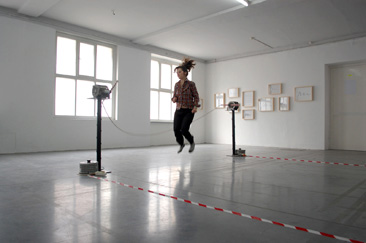
Marc Tobias Winterhagen
»The machine«
Poznan, Installation, PL 2011
When I think about my childhood, I remember not only ready-made toys, but also self-made toys, things made out of fantasy, and I remember of course playgrounds. I think that every person remembers at least one playground, on which he played when he was young. Nowadays, when I look at my little nephews, I see that they have so many things, so many toys to play with at home, they already have a Gameboy and know how to play with the Nintendo Wii, but at the same time I also see that they hardly play with other children and barely create their own toys or visualize an imaginary scenery to act and play in. They don’t put a blanket over a chair and imagine it being cave. I see that their fantasy isn’t a great one, not well developed. They have never played with paper planes, they rarely go to playgrounds or play with other children. Rope skipping is a game they and many other children at their age mostly have not heard of, let alone ever played yet. It is a vanishing game. Unfortunately.
Marc Tobias Winterhagen, *1977 in Frankfurt am Main, study of Multimedia-Communication at the Akademie der Schönen Künste Posen (2007-2010)
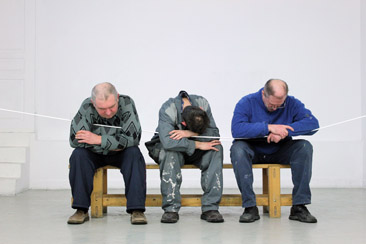
Elzbieta Wysakoska-Walters
»Sleeping on a line«
Poznan, Video Installation, PL 2010
‘In the mid 19th century, workhouses, doss houses and other cheap forms of accommodation began to spring up and these were usually dirty, overcrowded and very uncomfortable. The cheapest of all were the lodge houses, which were so cramped inside that people had to sleep sitting on a long bench, wedged in next to each other. As even the most dog tired still may have had trouble sleeping in a upright position, lodge owners would string a clothes line along the front of them at chest height, stretch it tight and folk could spend the night slumped over that. Early the following morning, the clothes line would be cut (...), waking the guests as they all crushed to the floor in front of them’ (J. Albert 2005 Shaggy Dogs & Black Sheep: The origins of even more phrases we use every day Penguin Books, London)
I was inspired by the social aspect of the experience and it seems to me that a reconstruction of the situation with the line, even without a prior knowledge of the context, could be a meaningful act for contemporary people. I feel that through bringing back the original, long forgotten, meaning, I open up for examination a profusion of meanings in contemporary culture. To start with the situation of migrant workers in contemporary Europe, and to arrive at the fragility or lack of security in contemporary society, the interdependency and outer forces regulating our lives. I am referring here to the overpowering feeling of helplessness and restriction.
Language, in this work, is a form of archive in which there is kept the knowledge about human experience. The examination of phrase etymology in contrast with contemporary conditions, or contemporary situation initiates reflection and documentation of contemporary phenomena in culture.
Elzbieta Wysakoska-Walters, studies Intermedia at the Fine Art Academy in Poznan, Poland.


